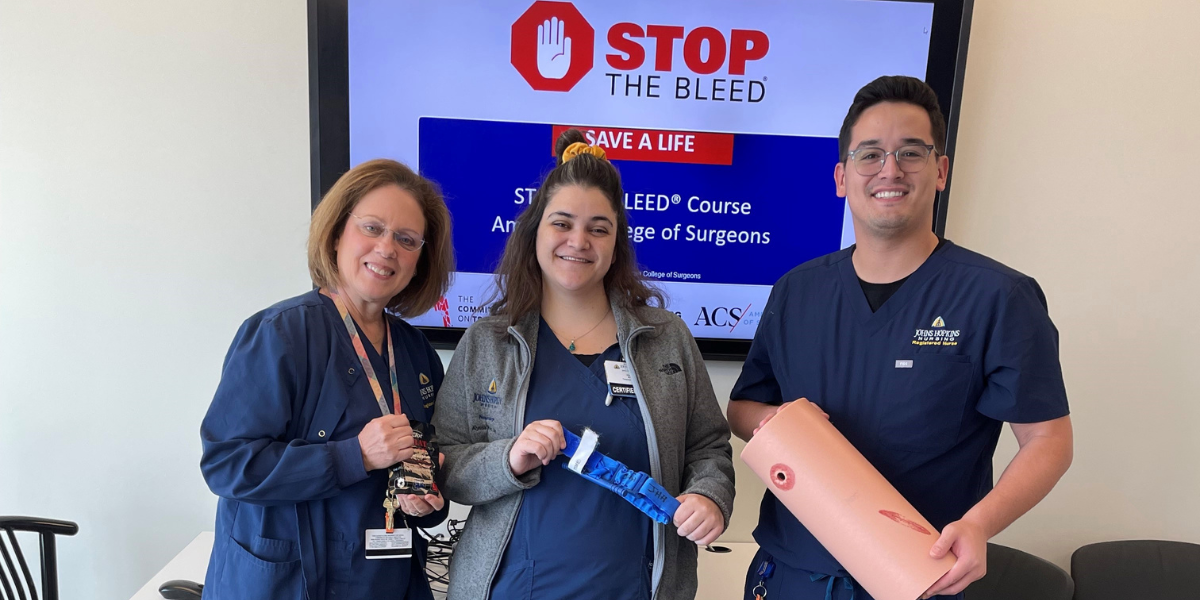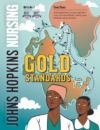From left, Judy Schroeder, adult trauma performance improvement/injury prevention coordinator, Alyssa Kasraii, a nurse on the Zayed 12 West Neuroscience Intermediate Care Unit, and Zakk Arciaga, adult trauma program manager. All are big believers in the STOP THE BLEED program.
Just a year out of nursing school, Alyssa Kasraii—a stroke and neurosurgical nurse on the Zayed 12 West neuroscience intermediate care unit at Johns Hopkins Hospital—was more than happy to take the STOP THE BLEED course recommended by her unit’s clinical nurse specialist, Lisa Klein.
“I’d never worked in trauma so it was a new skill, learning how to control life-threatening bleeding in
an emergency,” Kasraii says.
She was called upon to use that skill more quickly than she could have imagined. A week after she was taught the proper way to apply a tourniquet and how to pack and use her hands to put pressure on a potentially catastrophic wound, a man was shot outside a Baltimore apartment building where she was visiting a friend.
“It was a very chaotic situation and not something I’d ever experienced,” she says. “Lots of police officers doing a lot of things at once. But I told them I was a nurse and they handed me their own STOP THE BLEED kit. And because of the class I knew exactly what I was there to do.
“I had grabbed my friend’s jacket to use as a tourniquet, but the kit had a real tourniquet and gauze [treated with an anti-coagulant medication] to stuff the wound. If I hadn’t taken the course, I wouldn’t have felt confident stuffing the wound because I’d have been afraid it would hurt,” says Kasraii. “I knew I had to keep the patient calm and alert until the ambulance arrived. What I’d learned helped me stay calm in a tense situation and do what I needed to do.”
“I will go anywhere anybody will listen.”
STOP THE BLEED was inspired in part by the 2012 Sandy Hook Elementary School massacre, where it was determined that some victims may have survived if their bleeding had been staunched quickly enough. In addition, the U.S. Department of Defense (DOD) was finding that the use of tourniquets and putting pressure on wounds was having a significant impact on the survival of wounded soldiers. So the American College of Surgeons, under the aegis of the DOD, devised a simple course to teach people how to control bleeding during the first precious moments after a serious injury—much as CPR was originally developed to empower bystanders to help heart attack victims.
Judy Schroeder, adult trauma performance improvement/injury prevention coordinator, is a passionate advocate of STOP THE BLEED and over the past five years has trained more than 400 people, both on the Johns Hopkins campus and in the community. Training takes little more than an hour, and consists of a 25-minute PowerPoint presentation with two videos followed by practice among small groups.
“I offer a formal class on the Johns Hopkins Hospital campus every other month to all shifts,” Schroeder says. “But we have hundreds of trainers at Hopkins and we’ve trained thousands of people in the community—in schools, churches, businesses, book groups. I will go anywhere anybody will listen.”
Adult trauma program manager Zakk Arciaga says Johns Hopkins STOP THE BLEED educators focus on certain communities. “All of our trauma patients are in our database, so we can identify where the greatest number of penetrating injuries occur,” Arciaga says.
“Though we often think of shootings, these injuries are actually caused by everything from motor vehicle and industrial accidents to lawnmowers and kitchen knives,” he says. “Bleeding is the single biggest cause of preventable trauma deaths and can occur in just a few minutes, well before the arrival of emergency services. STOP THE BLEED gets people comfortable responding to these events before they happen.”
Alyssa Kasraii’s experience is a powerful case in point, says Schroeder. “We’re here to spread the
word, and her story is evidence that this training makes a difference.”
Anyone in the Baltimore community can ask about setting up a STOP THE BLEED training by sending an email to [email protected].
“We’ll go anywhere, anytime, with anybody,” Schroeder says.

